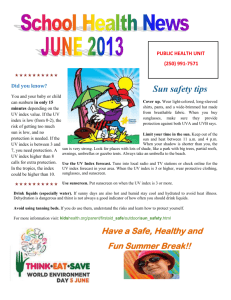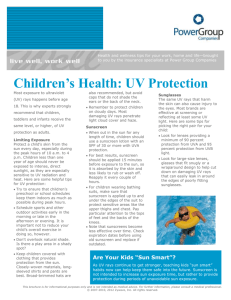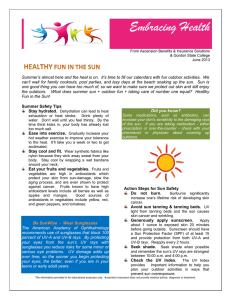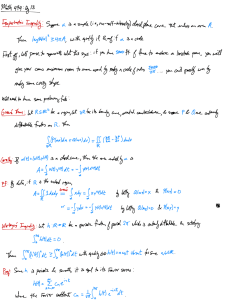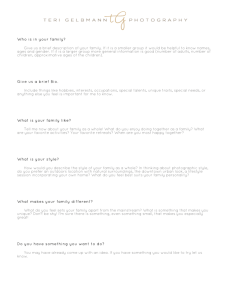Remember sun safety in the field How much do you know?
advertisement
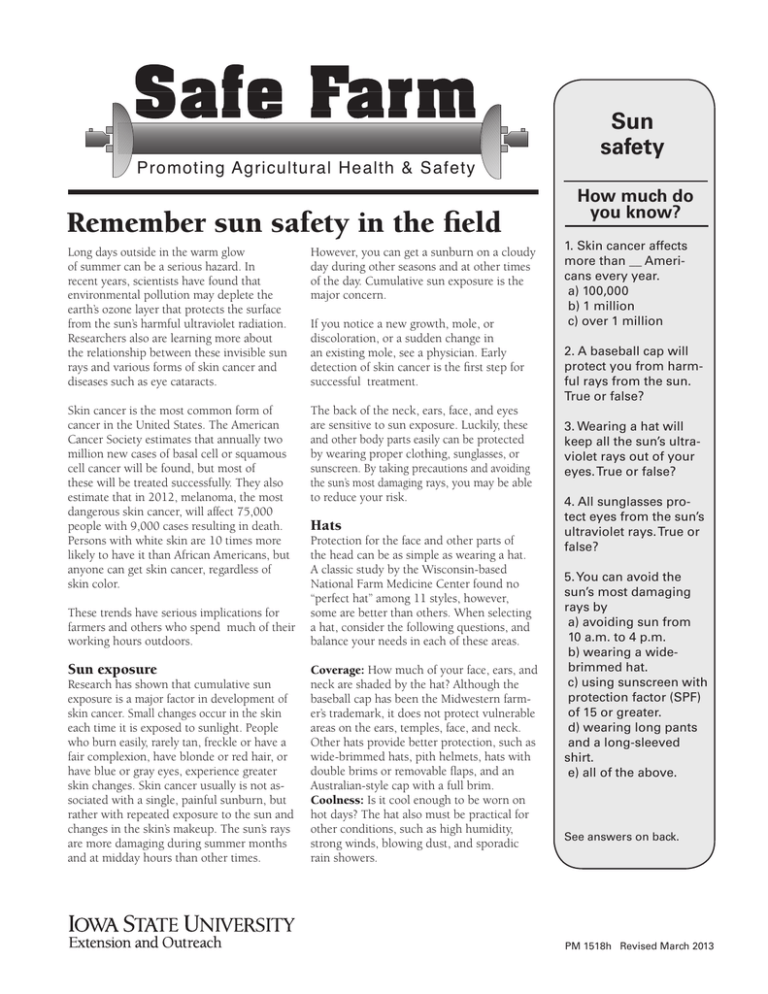
Promoting Agricultural Health & Safety Remember sun safety in the field Long days outside in the warm glow of summer can be a serious hazard. In recent years, scientists have found that environmental pollution may deplete the earth’s ozone layer that protects the surface from the sun’s harmful ultraviolet radiation. Researchers also are learning more about the relationship between these invisible sun rays and various forms of skin cancer and diseases such as eye cataracts. However, you can get a sunburn on a cloudy day during other seasons and at other times of the day. Cumulative sun exposure is the major concern. Skin cancer is the most common form of cancer in the United States. The American Cancer Society estimates that annually two million new cases of basal cell or squamous cell cancer will be found, but most of these will be treated successfully. They also estimate that in 2012, melanoma, the most dangerous skin cancer, will affect 75,000 people with 9,000 cases resulting in death. Persons with white skin are 10 times more likely to have it than African Americans, but anyone can get skin cancer, regardless of skin color. The back of the neck, ears, face, and eyes are sensitive to sun exposure. Luckily, these and other body parts easily can be protected by wearing proper clothing, sunglasses, or sunscreen. By taking precautions and avoiding the sun’s most damaging rays, you may be able to reduce your risk. These trends have serious implications for farmers and others who spend much of their working hours outdoors. Sun exposure Research has shown that cumulative sun exposure is a major factor in development of skin cancer. Small changes occur in the skin each time it is exposed to sunlight. People who burn easily, rarely tan, freckle or have a fair complexion, have blonde or red hair, or have blue or gray eyes, experience greater skin changes. Skin cancer usually is not associated with a single, painful sunburn, but rather with repeated exposure to the sun and changes in the skin’s makeup. The sun’s rays are more damaging during summer months and at midday hours than other times. If you notice a new growth, mole, or discoloration, or a sudden change in an existing mole, see a physician. Early detection of skin cancer is the first step for successful treatment. Hats Protection for the face and other parts of the head can be as simple as wearing a hat. A classic study by the Wisconsin-based National Farm Medicine Center found no “perfect hat” among 11 styles, however, some are better than others. When selecting a hat, consider the following questions, and balance your needs in each of these areas. Coverage: How much of your face, ears, and neck are shaded by the hat? Although the baseball cap has been the Midwestern farmer’s trademark, it does not protect vulnerable areas on the ears, temples, face, and neck. Other hats provide better protection, such as wide-brimmed hats, pith helmets, hats with double brims or removable flaps, and an Australian-style cap with a full brim. Coolness: Is it cool enough to be worn on hot days? The hat also must be practical for other conditions, such as high humidity, strong winds, blowing dust, and sporadic rain showers. Sun safety How much do you know? 1. Skin cancer affects more than __ Americans every year. a) 100,000 b) 1 million c) over 1 million 2. A baseball cap will protect you from harmful rays from the sun. True or false? 3. Wearing a hat will keep all the sun’s ultraviolet rays out of your eyes. True or false? 4. All sunglasses protect eyes from the sun’s ultraviolet rays. True or false? 5. You can avoid the sun’s most damaging rays by a) avoiding sun from 10 a.m. to 4 p.m. b) wearing a widebrimmed hat. c) using sunscreen with protection factor (SPF) of 15 or greater. d) wearing long pants and a long-sleeved shirt. e) all of the above. See answers on back. PM 1518h Revised March 2013 Comfort: How does the hat feel? Will it stay on during various tasks? Can you wear it around animals or in close quarters? Does it limit vision or hearing? Read the label to know when to re-apply sunscreen and whether it is waterproof. Sun avoidance Commitment: Will you wear it? The most well-designed hat is ineffective if it’s seldom worn. An ISU study found that farmers think it is most important for a hat to be made of sun-blocking material, have a full brim, be lightweight, and low in cost. The easiest way to reduce exposure to ultraviolet radiation is to avoid the sun. Critical times are midday hours between 10 a.m. and 4 p.m. This may be impossible for some active individuals, but scheduling tasks around this period could reduce exposure when the sun is most dangerous. Clothing Sunglasses Clothing helps block the ultraviolet rays (UVR) of the sun when it covers the skin. Wear long-sleeved shirts, long pants, and socks. You probably don’t need special clothes for sun protection if your clothes are washed in detergents with fabric brighteners, because they act as UVR absorbers. Closely woven or knitted fabrics are more protective because they lack open spaces to let UVR through to your skin. Clothes dyed in dark colors (black, navy, red) have more dye to absorb UVR and shield your skin than light colored ones. Light colored and white clothes may be manufactured to block UVR or washed using detergent with brighteners to improve their protection. Sunscreen lotions Parts of the body that are not covered by clothes can be protected with sunscreen lotions. Sunscreens are not a substitute for wearing proper clothing. They also can give users a false security. Sunscreens recommended for outdoor workers should have a sun protection factor (SPF) rating of at least 15. This means that you are protected from a reaction to the sun’s effects 15 times longer than you are without the sunscreen. Even the most effective hats can block only 50 percent of the ultraviolet rays that reach the eyes. A good shade hat combined with the use of sunglasses is a better way to protect eyes from sun exposure. Use caution when selecting sunglasses because they vary widely in the amount of protection from ultraviolet radiation. A peeloff label on the lens indicates its UV rating, or percentage of ultraviolet rays blocked by the sunglasses (the best rating is 100). If no information is provided by the manufacturer, the sunglasses may not offer any added protection. Remember that people who spend a lot of time outdoors in work or leisure activities can suffer from more than just exhaustion or heat stress. They are at risk for skin cancer and other diseases that result from years of exposure to the sun. Be aware of the risks and make it a habit to protect yourself from sun exposure. Prepared by Charles V. Schwab, extension safety specialist, and Janis Stone, extension textiles and clothing specialist. For more information Sun safety What can you do? ■ Examine the hat you wear for field work. Determine if it protects your ears, face, temples, and neck from the sun. ■ Visit your doctor regularly to determine whether you have the warning signs of skin cancer. ■ Encourage employees and family members to use proper eye and skin protection from the sun. ■ Check the UV rating of your sunglasses. If the rating is low or you cannot find it, purchase new glasses with a higher rating. ■ Select sunscreen lotion that provides adequate protection for your situation. Keep it handy and use it when needed. Answers to quiz: 1-c; 2-False; 3--False; 4-False; 5-e Information about skin cancer is available from: American Cancer Society, www.cancer.org American Academy of Dermatology, www.aad.org/ U.S. Centers for Disease Control and Prevention, www.cdc.gov/cancer/skin Promoting Agricultural Health & Safety Safe Farm is an Iowa State University Extension and Outreach project helping to make Iowa farms a safer place to work and live. … and justice for all The U.S. Department of Agriculture (USDA) prohibits discrimination in all its programs and activities on the basis of race, color, national origin, age, disability, and where applicable, sex, marital status, familial status, parental status, religion, sexual orientation, genetic information, political beliefs, reprisal, or because all or part of an individual’s income is derived from any public assistance program. (Not all prohibited bases apply to all programs.) Persons with disabilities who require alternative means for communication of program information (Braille, large print, audiotape, etc.) should contact USDA’s TARGET Center at 202-720-2600 (voice and TDD). To file a complaint of discrimination, write to USDA, Director, Office of Civil Rights, 1400 Independence Avenue SW, Washington, DC 20250-9410, or call 800-795-3272 (voice) or 202-720-6382 (TDD). USDA is an equal opportunity provider and employer. Issued in furtherance of Cooperative Extension work, Acts of May 8 and June 30, 1914, in cooperation with the U.S. Department of Agriculture. Cathann A. Kress, director, Cooperative Extension Service, Iowa State University of Science and Technology, Ames, Iowa. For more safety information, check the web at www.abe.iastate.edu.
